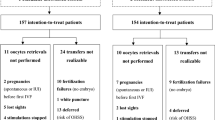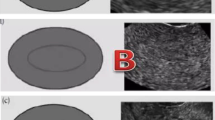Abstract
Purpose: The importance of endometrial maturation at estimated time of implantation for the outcome of IVF treatment in regularly menstruating women with tubal infertility was evaluated.
Methods: FSH was measured on cycle day 3, on days 10–15 urine and blood were collected to estimate the day of the LH peak, and E2 and P4 were measured during the luteal phase, on cycle days 19–26. An endometrial biopsy was obtained on days LH + 3 to LH + 6.
Results: The number of subjects with delayed endometrial maturation was larger in the group of infertile women who did not become pregnant compared to pregnant women and controls. Those infertile women who did not become pregnant after IVF treatment also presented with a higher basal FSH on cycle day 3 and lower E2 and P4 AUC in the luteal phase. Six infertile women and two controls presented with mid- and late-proliferative endometrium in the luteal phase on cycle days LH + 3 to LH + 6, in the presence of adequate E2 and P4 secretion. Six morphological characteristics were compared in the three groups: (1) 17 infertile women who became pregnant, (2) 18 who did not become pregnant, and (3) 28 controls. The pregnant infertile women did not differ from the controls. The numbers of glandular and stromal mitoses were significantly higher in those women who did not become pregnant (P<0.01) compared with those who became pregnant. Endometrial biopsies obtained on cycle days LH + 5 and LH + 6 showed significant differences in glandular epithelial height (P<0.05) and number of vacuolated cells among the nonpregnant women (P<0.01), the pregnant women (P<0.05), and controls.
Conclusions: A higher frequency of retarded endometrial development in women who did not become pregnant following IVF treatment was found. In some cases, endometrial insensitivity could most likely cause retarded endometrial development and failure of implantation after IVF treatment, which could not be overcome by routine luteal-phase support. However, our results do not allow conclusions concerning its relative importance compared to preembryo quality; this has to be investigated further.
Similar content being viewed by others
References
Noyes RW, Hertig AT, Rock J: Dating the endometrial biopsy. Fertil Steril 1950;1:3–25
Jones GS: Some newer aspects of management of infertility. JAMA 1949;141:1123
Wentz AC: Endometrial biopsy in the evaluation of infertility. Fertil Steril 1980;33:121–124
Balasch J, Creus M, Marquez M, Bruzaco I, Vanrell JA: The significance of luteal phase deficiency on fertility: A diagnostic and therapeutic approach. Hum Reprod 1986;1:145–147
Li TC, Dockery P, Cooke ID: Endometrial development in the luteal phase of women with various types of infertility: Comparison with women of normal fertility. Hum Reprod 1991;6:325–330
Li TC, Dockery P, Rogers AW, Cooke ID: A quantitative study of endometrial development in the luteal phase: Comparison between women with unexplained infertility and normal fertility. Br J Obstet Gynaecol 1990;97:576–582
Johannisson E, Parker RA, Landgren B-M, Diczfalusy E: Morphometric analysis of the human endometrium in relation to peripheral hormone levels. Fertil Steril 1982;38:564–571
Li TC, Rogers AW, Dockery P, Lenton E, Cook ID: A new method of histologic dating of human endometrium in the luteal phase. Fertil Steril 1988;50:52–60
Landgren B-M, Undén AL, Diczfalusy E: Hormonal profile of the cycle in 68 normally menstruating women. Acta Endocrinol (Kbh) 1980;94:89–98
WHO: Laboratory Manual for the Examination of Human Semen and Sperm-Cervical Mucus Interactions. Cambridge, WHO, 1987, pp 9–11
Johannisson E, Landgren B-M, Rohr HP, Diczfalusy E: Endometrial morphology and peripheral hormone levels in women with regular menstrual cycles. Fertil Steril 1987;48:401–408
Csemiczky G, Hagenfeldt K, Wramsby H: Selection of ovarian stimulation protocol is related to IVF treatment outcome in women 35 years of age and older. J Assist Reprod Genet 1994;11:474–477
Csemiczky G, Wramsby H, Landgren B-M: Ovarian function in relation to the outcome of IVF treatment in regularly menstruating women with tubal infertility. J Assist Reprod Genet 1995;12:683–688
Li TC, Dockery P, Thomas P, Rogers AW, Lenton E, Cook ID: The effect of progesterone receptor blockade in the luteal phase of normal fertile women. Fertil Steril 1988;50:732–742
Gordon M, Kohorn E, Gore B, Rice S: Effect of postovulatory oestrogens on the fine structure of the epithelial cells in the human endometrium. J Reprod Fertil 1973;34:375–378
Wynn R: Histology and structure of the human endometriumIn Biology of the Uterus, RM Wynn (ed) New York, London, Plenum Press, 1977, pp 341–376
Cornille FJ, Lauweryns JM, Brosens IA: Normal human endometrium. Gynecol Obstet Invest 1985;20:113–129
Israel R, Mishell DJ, Stone S, Thorneycroft I, Moyer D: Single luteal phase progesterone assay as an indicator of ovulation. Am J Obstet Gynecol 1972;112:1043
Radwanska E, Swyer GM: Plasma progesterone estimation in infertile women and in women under treatment with clomiphene and chorionic gonadotropin. Br J Obstet Gynecol 1974;81:107–112
Li TC, Lenton E, Dockery P, Rogers AW, Cook ID: The relation between daily salivary progesterone profile and endometrial development in the luteal phase of fertile and infertile women. Br J Obstet Gynecol 1989;96:445–453
Cooke ID, Morgan CA, Parry TE: Correlation of endometrial biopsy and plasma progesterone levels in women. J Obstet Gynecol Br Commonwlth 1972;78:647–650
Cumming DC, Honore LH, Scott JZ, Williams KP: The luteal phase in infertile women: comparison of simultaneous endometrial biopsy and progesterone levels. Fertil Steril 1985;43:715–719
Lutjen P, Trounson A, Leeton J, Findlay J, Wood C, Renov P: The establishment and maintenance of pregnancy using in vitro fertilization and embryo donation in a patient with primary ovarian failure. Nature 1984;307:174–175
Rosenwaks Z: Donor eggs: Their application in modern reproductive technologies. Fertil Steril 1987;47:895–909
Droesch K, Navot D, Scott R, Kreiner D, Liu H, Rosenwaks Z: Transdermal estrogen replacement in ovarian failure for ovum donation. Fertil Steril 1988;50:931–934
Navot D, Bergh P, Williams M, Garrisi G, Guzman I, Sandler B, Fox J, Schreiner-Engel P, Hofmann G, Grunfeld L: An insight into early reproductive processes through the in vivo model of ovum donation. J Clin Endocrinol Metab 1991;72:408–414
Meldrum D: Female reproductive aging-ovarian and uterine factors. Fertil Steril 1993;59:1–5
Navot D, Drews M, Bergh P, Guzman I, Karstaedt A, Scott R, Garrisi G, Hoffman G: Age related decline in female fertility is not due to diminished capacity of the uterus to sustaine embryo implantation. Fertil Steril 1994;61:97–10
Erenus M, Erenus M, Zouves C, Rajamahendran P, Leung S, Fluker M, Gomel V: The effect of embryo quality on subsequent pregnancy rates after in vitro fertilization. Fertil Steril 1991;56:707–710
Steer C, Mills C, Tan SL, Campbell S, Edwards R: The cumulative embryo score: A predictive embryo scoring technique to select the optimal number of embryos to transfer in an in vitro fertilization and embryo transfer program. Hum Reprod 1992;7:117–119
Gioretti C, Terrou P, Auquier P, Hans E, Spach J-L, Salzman J, Roulier R: Embryo score to predict implantation after in vitro fertilization: based on 957 single embryo transfers. Hum Reprod 1995;10:2427–2431
Author information
Authors and Affiliations
Rights and permissions
About this article
Cite this article
Csemiczky, G., Wramsby, H., Johannisson, E. et al. Importance of endometrial quality in women with tubal infertility during a natural menstrual cycle for the outcome of IVF treatment. J Assist Reprod Genet 15, 55–61 (1998). https://doi.org/10.1007/BF02766825
Received:
Accepted:
Issue Date:
DOI: https://doi.org/10.1007/BF02766825




